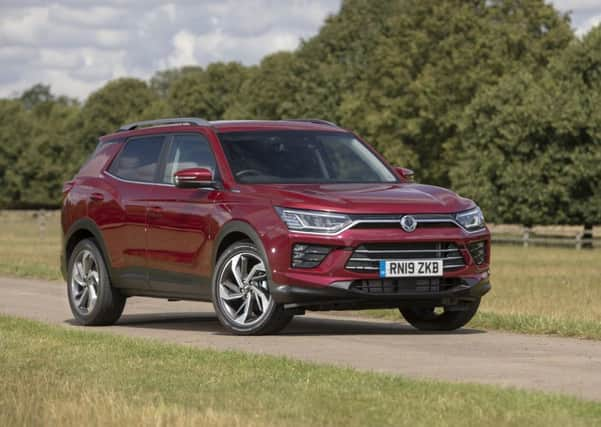Review: Ssangyong Korando


Now in its fourth generation, Ssangyong hopes the latest Korando can be a more compelling rival to market mainstays like the Nissan Qashqai and Kia Sportage, and transform the firm from an also-ran into a more credible option.
Comparing the new Korando to the previous generation is like comparing chalk and cheese. Ssangyong has done a remarkable job of transforming the crossover into a sharper model after the previous generation’s much curvier look.
Advertisement
Hide AdAdvertisement
Hide AdThat means a clearer touchscreen infotainment set-up, a fleet of driver assistance systems and a new engine line-up incorporating both diesel and petrol units.
Ssangyong is offering the latest Korando with two engines in the UK – a 1.6-litre diesel and a 1.5-litre turbocharged petrol engine, with the latter arriving on these shores in December. The petrol will be paired to either a six-speed automatic or six-speed manual transmission – although the manual won’t be available until January next year – while two and four-wheel drive is offered as well. The diesel is only supplied with the auto box and four-wheel drive.
With the 1.6-litre diesel, the Korando has 134bhp and 324Nm of torque at its disposal, allowing the crossover to get from 0-60mph in just under 12 seconds and reach a top speed of 112mph – although performance isn’t likely to be a deciding factor for potential Korando drivers.
Ssangyong claims that the Korando, in top-spec Ultimate guise with the diesel engine and four-wheel drive, will achieve economy figures of 43.5mpg and 171g/km CO2, although these are yet to be finalised.
On start-up or when pulling out from a junction, the diesel unit can sound a bit gruff and the gearbox can lag after putting your foot down. But once out and about, the Korando quietens down and becomes pleasant to cruise in. Around the twisty and narrow Cotswolds test route, the Korando doesn’t feel too big either, while the lighter than expected steering makes it great around town.
Ssangyong UK’s managing director Nick Laird said the new Korando was looking to be more than just an option for people who tow, but the lower down torque of the diesel will still cater to the model’s usual market. The Korando does, however, feel overly firm for our liking, and having tried the model on both the entry-level 17-inch and top-spec 19-inch alloys, that feeling is consistent across the range.
The four-wheel-drive option is the one to go for, as the front-wheel-drive doesn’t put its power down as smoothly making progress less fluid, while the steering isn’t quite as direct.
This is easily the most handsome Korando so far and the South Korean firm has done a great job of helping it stand out. The sharper lines of the bonnet, wheel arches and rear end make this model much more appealing and modern than before. Having the extra chrome detailing across the front grille and at the back make the Korando look that bit more upmarket too.
Advertisement
Hide AdAdvertisement
Hide AdBoth the mid-spec Pioneer and top-end Ultimate editions look good, but the Ultimate version comes with some stylish five-spoke 19-inch alloy wheels that match the car better and look marginally better.
Ssangyong has made a large step in terms of quality with the Korando, and the interior of the Ultimate model we drove was very pleasant indeed. Fitted with heated and ventilated leather seats, a sturdily built centre console and clear displays, the cabin feels up to the level of its closest rivals – and in the case of the screens, it’s better.
The cabin is very spacious, with even a tall driver behind the wheel allowing enough space in the back for adult passengers. The boot is a tad small, although there is underfloor storage space on the Ultimate model. That means a load space of 551 litres, which can be extended to 1,248 litres with the rear bench folded down.
As far as the spec is concerned, the Ultimate is the pick of the four-trim offerings. Starting from a competitive £26,495 with the forthcoming petrol engine installed, this Korando gets all-leather seats, dual-zone climate control, a nine-inch touchscreen infotainment display, Apple CarPlay and Android Auto connectivity, a 10.25-inch customisable digital instrument display and a powered tailgate.
LED headlights, rear privacy glass, interior mood lighting and 19-inch alloy wheels help finish the look. Starting from the same price as the Ultimate model, Pioneer models feature a two-tonne towing capacity, leather and cloth upholstered seats, 17-inch alloy wheels, heated front seats, parking sensors and an eight-inch touchscreen. Although it may not be as well-equipped as the Ultimate, this version is squarely aimed at the towing market.
Verdict
While the Korando may not have been in contention for many crossover buyers, this new version should be. Its driving experience does fall a little short of its closest rivals, but the fourth iteration of the Korando is a much better package than before and can hold a candle to its South Korean rivals. The Ssangyong brand isn’t as well-known as Hyundai or Kia, but the new Korando could bring it into the public view more than ever.